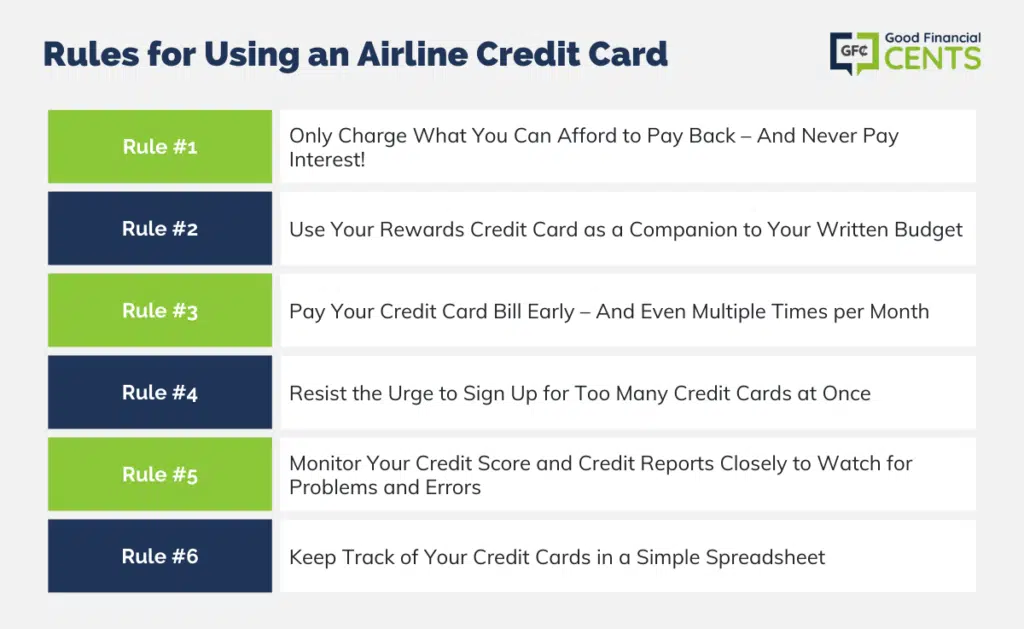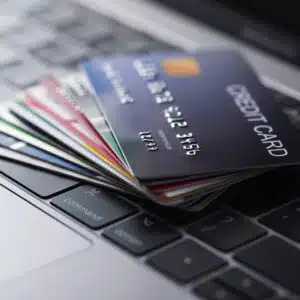If you travel often and spend a lot of money on airfare, the best airline credit cards can help take the sting out of your travel budget. By signing up for the right cards, you can earn airline miles for free travel plus perks that make your travel experience a lot more fun.
Still, knowing which airline credit card is right for your situation and travel style requires some work and research on your part. The right card for your needs not only depends on where you live and which airports you are close to but also on where you want to travel to – plus, how often.
This guide was created to introduce the top airline credit card offers, plus some of the best ways to use them. If you want to eventually fly for free, keep reading.
But as a friendly reminder, we recommend you not maintain a balance on your credit card. Pay it off as you go to help maintain a good credit score range.
Before we dig into each individual card and how its individual rewards program works, here are the top cards to consider:
Table of Contents
Top 10 Best Airline Credit Cards for 2025
- Chase Sapphire Preferred®
- Southwest Airlines Rapid Rewards Premier®
- Citi ThankYou® Premier
- British Airways Visa Signature®
- United MileagePlus® Explorer
- Citi/AAdvantage® Platinum Select® MasterCard
- Discover it® Miles
- Barclaycard Arrival Plus™ World Elite MasterCard®
- BankAmericard Travel Rewards®
- JetBlue
1. Chase Sapphire Preferred® Card: Best Option for Flexible Rewards
While the Chase Sapphire Preferred® Card isn’t necessarily an airline credit card, it does let you earn points that transfer to some of the most popular airline loyalty programs in the business.
After spending just $4,000 on your card within 90 days, you’ll earn 50,000 points worth $625 in travel if you book through the Chase Ultimate Rewards portal.
When you transfer points to an airline program affiliated with Chase, you’ll get an awesome 1:1 transfer ratio. Currently, Chase transfer partners include:
- United Airlines
- Southwest Airlines
- British Airways
- JetBlue TrueBlue
- Singapore KrisFlyer
- Virgin Atlantic
- Aer Lingus
- Iberia Plus
- Flying Blue AIR FRANCE KLM
- Hyatt
- Marriott
- Ritz-Carlton
- IHG
If you’re not sure which airline you want to invest in and want plenty of options, the Chase Sapphire Preferred® Card is probably your best bet. Here are some details to consider before you sign up.
- Earn 50,000 points after you spend $4,000 within 90 days of account opening
- Earn 2X points on travel and dining, plus 1X points on all purchases
- $95 annual fee, waived the first year
- No foreign transaction fees
- Free primary auto coverage, plus trip cancellation/interruption insurance
2. Southwest Airlines Rapid Rewards Premier® Credit Card: Best for Flexible Booking
If you’re looking for a family-friendly airline, look no further than Southwest Airlines and the Southwest Airlines Rapid Rewards Premier® Credit Card.
Not only do they offer your first two checked bags for free on every flight, but they also have an awesome rewards program that makes family travel a piece of cake.
With the current offer on this card, you’ll earn 40,000 miles after you spend just $1,000 within the first three months of account opening. Plus, you’ll earn 2x points on travel purchases with the airline and 1x points for every dollar you spend elsewhere.
The best part about this program, however, is the fact that there are no blackout dates or capacity controls. If there is a seat on the plane and you have the points to book it, it’s yours!
- Earn 40,000 points after you spend just $1,000 on your card within 90 days
- Earn 2x points on Southwest purchases, plus 1x points for every dollar you spend
- 6,000 points for every anniversary
- $99 annual fee
3. Citi ThankYou® Premier Card: Best for Diverse Transfer Partners
The Citi ThankYou® Premier Card is similar to the Chase Sapphire Preferred® Card in the fact that there are several ways you can redeem your points.
With this card, you’ll earn 3X ThankYou points on travel, including gas, 2X ThankYou Points on dining out and entertainment, and 1X ThankYou Points on all other purchases.
Plus, you can transfer your points to the following transfer partners:
- Asia Miles
- EVA Air Infinity MileageLands
- Etihad Guest
- Garuda Indonesia Frequent Flyer
- Flying Blue
- Malaysia Airlines Enrich
- Qantas Frequent Flyer
- Qatar Airlines Privilege Club
- Singapore Airlines KrisFlyer
- Thai Airways Royal Orchid Plus
- Virgin America Elevate
- Virgin Atlantic Flying Club
Before you sign up for the Citi ThankYou® Premier Card, here are some of the key features to consider:
- Earn 50,000 bonus points after you spend $4,000 in purchases on your card within the first three months.
- Earn 3X ThankYou points on travel, including gas, 2X ThankYou Points on dining out and entertainment, and 1X ThankYou Points on all other purchases
- $95 annual fee, waived the first year
- Points never expire and your earnings are unlimited
- No foreign transaction fees
4. British Airways Visa Signature® Card: A Solid Option for Domestic and Caribbean Itineraries
The current offer on the British Airways Visa Signature® Card lets you earn the signup bonus in phases.
At the moment, you’ll earn 50,000 Avios after you spend $3,000 on your card within the first three months, an additional 25,000 Avios after you spend $10,000 on your card, and an additional 25,000 Avios after you spend $20,000 on your card within the first year.
You also earn 3 Avios(points) per dollar spent on British Airways and 1 Avios for all your other purchases.
To put things in perspective, flights less than 1,150 miles now cost only 7,500 Avios per leg. This makes this card an exceptionally good value for shorter flights throughout the U.S. and flights to the Caribbean from southern hubs in places like Miami and Dallas.
And since British Airways is a Chase transfer partner, this is an excellent card to pair with the Chase Sapphire Preferred® Card.
Before you sign up, read these details:
- Earn 50,000 Avios after you spend $3,000 on your card within 90 days, an additional 25,000 Avios after you spend $10,000 on your card, and an additional 25,000 Avios after you spend $20,000 on your card within the first year
- No foreign transaction fees
- Upgraded chip technology
- $95 annual fee
5. United MileagePlus® Explorer Card: A Great Option for International Fares
Whether you fly domestically or abroad, the United MileagePlus® Explorer Card can offer a ton of value. Flights to Europe, for example, can run as little as 60,000 miles per leg. Plus, one-way saver awards on domestic itineraries can cost just 10,000 miles per leg.
With the current offer on this card, you’ll earn 40,000 miles after you spend just $2,000 on your card within the first 90 days. You can then earn 25,000 more miles if you spend $10,000 within the first 6 months.
You’ll also get your first checked bag for free, priority boarding, and no foreign transaction fees when you use your card outside of the United States.
You’ll get 2 miles per $1 at restaurants and hotels booked directly through the hotel, United tickets and purchases, and 1 mile per dollar on all other purchases.
- Earn 40,000 miles after spending just $2,000 on your card within 90 days
- $95 annual fee, waived the first year
- Get your first checked bag free
- Your miles will never expire as long as your credit card account is open
6. Citi/AAdvantage® Platinum Select® MasterCard: Best for International Flights
With the Citi/AAdvantage® Platinum Select® MasterCard, you’ll earn 40,000 AAdvantage miles after you spend just $2,000 on your card within the first three months and 10,000 when you spend $6,000 during your first year.
Plus, you’ll earn 2x points on American Airlines purchases and 1x points for every other dollar you spend.
Fortunately, those points can go fairly far if you know how to use them. With this card, you’ll also get a first checked bag free for you and four of your travel companions on domestic itineraries, which will save you more than $100.
Plus, you’ll get Group 1 boarding on domestic American Airlines flights.
- Earn 60,000 miles after you spend just $3,000 on your card within 90 days
- Get a free checked bag for you and up to four travel companions on domestic itineraries
- $95 annual fee, waived the first year
7. Discover it® Miles – Double Your Miles for First Year
The Discover it® Miles offers a unique way to earn free airfare. Instead of earning airline miles, you earn “miles” you can use to book airfare on any airline at any price!
With this card, you’ll earn 1.5 miles for every dollar you spend – plus Discover promises to double all the miles you earn at the end of your first year!
If you manage to earn 20,000 miles the first year, for example, Discover will double that amount to 40,000 miles after 12 months. Those 40,000 miles would then be worth $400 in airfare with any airline.
Another perk that comes with this card is the fact that you get a free FICO score on your monthly statement. Plus, it doesn’t charge an annual fee, so you can keep it for the long run.
- Earn 1.5 miles for every dollar you spend, plus Discover will double your miles after the first year
- No annual fee
- No blackout dates
- Free FICO score on your monthly statement
8. Barclaycard Arrival Plus™ World Elite MasterCard®
Although the Barclaycard Arrival Plus™ World Elite MasterCard® is considered a “flexible” travel credit card, it works great for flights.
Simply use your card to spend $5,000 within the first 90 days, and you’ll earn 60,000 “miles” worth $600 in travel. Once you rack up all those miles, you can use them to book a free flight with any airline without worrying over blackout dates or capacity controls.
Since you’ll earn 2x miles per dollar spent, this is one of the easiest airline cards to deal with. You won’t have to worry about certain category bonuses or using your card for certain types of spending; simply use your card for every purchase you need to make with credit to earn 2x miles for every dollar you spend.
If you’re unsure of which airline you want to go with – or don’t like to jump through the hoops required by certain airline loyalty programs – this card is a great option in that respect as well. Since your miles work as “travel credit,” you can use them for any airline and for any flight.
- Earn 60,000 miles after you spend just $5,000 on your card within 90 days
- Earn 2x miles for every dollar you spend
- No limit on the number of miles you can earn
- $89 annual fee and 0% APR for the first 12 months
9. Bank of America® Travel Rewards Credit Card
The Bank of Americard® Travel Rewards Credit Card is another card that offers some flexibility yet is perfect as an airline credit card.
By signing up, you’ll earn 1.5 points for every dollar you spend with no limits, plus 25,000 online bonus points if you use your card for $1,000 in purchases within the first 90 days.
Once you start racking up the points, you can redeem them for statement credits to cover any airfare purchase at a rate of one cent per point. For example, the 25,000 point signup bonus is worth $250 in airfare.
Since this is a flexible rewards card, however, you can use your points to book with any airline. This is especially helpful if you want to shop around for the best price, or if you’re initially unsure of which airline you want to use.
And with a minimum spending requirement of just $1,000 within the first 90 days, this card offers one of the smallest hurdles to earning the initial signup bonus. As an added bonus, this card will never charge an annual fee!
- Earn 25,000 bonus points after you spend just $1,000 in 90 days
- Earn an unlimited 1.5 points for every dollar you spend
- No annual fee
- Redeem your points with any airline without worry over blackout dates
10. JetBlue Card
The JetBlue Card from Barclays Bank is one of the newest airline credit cards on the market. For the most part, this card is geared to people who already fly JetBlue often and want to earn points every time they pay for airfare.
By signing up, you’ll earn 3x points on JetBlue purchases, 2x points at restaurants and grocery stores, and 1 point per dollar spent on all other purchases. As an added bonus, you’ll also earn a signup bonus after you spend $1,000 on your card within the first 90 days.
The best part about the new JetBlue Card is that it doesn’t charge an annual fee. So if you already fly JetBlue often, you really have nothing to lose by signing up.
Also, this card’s loyalty program promises no blackout dates and points that will never expire. Before you sign up, here are some additional details to consider:
- Earn 10,000 JetBlue points after you spend $1,000 within the first 90 days of membership
- Earn 3x points on JetBlue purchases, 2x points at restaurants and grocery stores, and 1x points on all other purchases.
- Never pay an annual fee
- No blackout dates and points never expire
How to Get the Most Out of Your Airline Credit Card
Unlike the points you earn with cash back credit cards and flexible rewards cards, airline miles come with an added layer of complexity.
Here are some tips that can help you get the most out of the miles you earn:
Know Your Local Airlines.
Before you sign up for an airline credit card, you should make sure that the airline actually operates out of your local airport.
While that sounds obvious, you wouldn’t believe how many people go through the trouble of earning airline miles only to find the airline only operates on a limited basis nearby – or doesn’t have a hub at their airport at all!
Understand Airline Rewards Programs Before You Sign Up.
Before you sign up for an airline credit card, it helps to have an idea of where you want to travel and when. That way, you can figure out how many miles you need and create a strategy to make it happen before you get started.
And since certain airline programs work better out of specific airports and for specific itineraries, it helps to have a cursory understanding of how each program works before you invest your time in earning miles.
Consider Flexible Cards if You Travel Mostly During Peak Travel Periods.
Since airline miles are notoriously hard to use during peak travel times, you may be better off with a flexible rewards credit card – or even a cash back card – if you only travel over the holidays or during school breaks.
Trust us, nothing is worse than having a ton of airline miles you can’t use!
Since the Chase Sapphire Preferred® Card lets you transfer your points to popular airlines like United MileagePlus, Southwest Airlines, and British Airways, this card is a no-brainer for people who want some flexibility in how they travel.
Don’t Forget About Taxes and Fees.
Even though airline miles can make your flight “free,” you’ll still be on the hook for government-mandated taxes and fees. For domestic itineraries, this is normally only $5.60 per leg. For international flights, however, these taxes and fees can cost several hundred dollars.
Since airfare can be the most expensive component of any family vacation, earning airline miles is definitely worth the effort. With the right card or combination of cards, you can even earn almost free airfare for your whole family.
And if you add in a hotel credit card or two, you can easily score an almost-free vacation. All it takes is some planning and some time.
Airline Credit Cards: Strategies to Consider
If you’re wondering which airline credit card to sign up for, you’re not alone. The complexity of airline loyalty programs makes it difficult to figure out which program is best for you.
That’s why many people choose a flexible travel credit card at the start. By opting to sign up for the Chase Sapphire Preferred® Card, for example, you can earn points to transfer to a handful of popular airlines, including Southwest, British Airways, United, and Korean Air, to name a few.
If you’re unsure which program might benefit you the most, having more than one option from the start is extremely smart.
Here are a few specific airline credit card strategies that could help you earn a whole lot more points over time:
Pair a Flexible Card With a Co-branded Airline Card to Earn Even More Points!
If you want to earn as many airline miles as possible, it can pay to create a strategy that involves both a flexible credit card and a co-branded airline credit card. For example, let’s say you’re obsessed with flying on Southwest Airlines.
By getting both the Southwest Airlines Rapid Rewards Premier®Credit Card and the Chase Sapphire Preferred® Card, you can earn two signup bonuses!
Get Your Spouse Involved.
Since airline miles don’t always go as far as they used to, getting your spouse involved can be a really smart move. Obviously, earning two signup bonuses is a lot better than earning one. And with double the miles, you can travel more often or travel much further from home.
Get a Card That Doesn’t Earn Actual Airline “Miles” as Well.
If you want to earn free airfare but hate the idea of messing with an airline loyalty program or searching for award availability, a flexible card like the Discover it®Miles might be a much better value.
With this card, you’ll earn points you can redeem with any airline without having to worry about award availability or blackout dates. You can also get this card as a companion to your other travel credit cards, then use it to cover part of your travel expenses.
Rules for Using an Airline Credit Card
Using credit cards for rewards can be a smart way to save money on travel, but only if you know what you’re doing. If you don’t jump into the game with the right mindset, it’s far too easy to let your desire for rewards pull you into a cycle of overspending and debt.
To avoid getting into trouble – and keep your credit in tip-top shape, we created this list of rules everyone pursuing credit card rewards should follow.
Before you sign up for an airline credit card, you should commit to following each of these rules – with no exceptions:
Rule #1: Only Charge What You Can Afford to Pay Back – And Never Pay Interest!
When you’re pursuing credit card rewards, this is the most important rule to remember. You should only use credit to charge what you can afford to pay back, and you should never consider any exception to that rule.
Most rewards credit cards charge interest rates that are higher than average to compensate for the fact that they dole out rewards. Because of this, carrying a balance on your card can be absolutely detrimental to your finances – and your budget.
By only charging what you can afford, you can avoid paying interest on your purchases and stay out of debt. And if you find yourself getting into debt or struggling to pay your credit card bill for any reason, you should stop using a credit card altogether.
Remember:
Rule #2: Use Your Rewards Credit Card as a Companion to Your Written Budget.
One way to avoid getting into debt or overspending is using your airline credit card as a companion to your written budget. With this strategy, you’ll create a written plan each month that includes each of your bills and expenses.
Then, you’ll use your credit card to pay all bills and expenses you can, only to turn around and pay it off right away.
Let’s say you budget $600 for groceries this month. By using your airline credit card, you could earn a lot of miles if you charged your grocery bill each time you visited the store.
You can also pay bills like utility bills, insurance, and even daycare. The key is, turning around and paying that credit card bill as quickly as you can.
Rule #3: Pay Your Credit Card Bill Early – And Even Multiple Times per Month.
In my opinion, the best way to make sure your bills are under control is to pay your credit card bill early or extremely early. You don’t want to wait until the last minute to pay your bill, nor do you want to take the chance of letting it arrive late.
By paying your bill early – or really early – you can avoid late fees and or damage to your credit score. Plus, you’re a lot more likely to stay “on track” with your budget and spending plan.
If you’re worried about overspending or forgetting to make your payment on time, you can also commit to making multiple payments per month.
By paying your credit card bill in full every Friday, for example, you can stay on track with your budget, avoid paying interest on your purchases, and ensure your bill is on time every month.
Rule #4: Resist the Urge to Sign Up for Too Many Credit Cards at Once.
With so many credit cards offering a huge signup bonus at any given time, it can be tempting to sign up for all of them. Before you choose a credit card or more than one card, you should stop and think about your long-term strategy – and your credit.
Using the FICO credit scoring method, “new credit” makes up 10 percent of your credit score. Any time you apply for a new line of credit, your score can drop a few points. Because of this, applying for several or a lot of cards at once could make your score plummet if you’re not careful.
If you want to stay on the safe side, you should only sign up for a few new credit cards per year. While earning a lot of signup bonuses is nice, you don’t want to take too big of a hit to your credit.
Rule #5: Monitor Your Credit Score and Credit Reports Closely to Watch for Problems and Errors.
As you start using credit cards in pursuit of rewards, it’s crucial to monitor your credit. The more credit accounts you have open, the more susceptible you are to someone using your card(s) in a fraudulent way. Plus, you’ll want to make sure all of your credit activity is being reported correctly.
The Federal Trade Commission offers a resource that describes the various ways you can get a free credit score as well as a free copy of your actual credit report every year.
According to the FTC, the Fair Credit Reporting Act (FCRA) requires each of the main credit reporting agencies – Experian, Equifax, and TransUnion – to provide you with a free copy of your credit report every year. To take advantage, however, you have to go through the effort of signing up.
Rule #6: Keep Track of Your Credit Cards in a Simple Spreadsheet.
Once you have more than a few rewards credit cards, it’s easy to struggle to keep track of each card’s details. That’s why we suggest keeping a simple spreadsheet with details on each card.
You can create this spreadsheet any way you want, but we suggest keeping track of each card’s name, when you earned the signup bonus, and when the annual fee on each card comes due at the very minimum.
By keeping all of this information in one place, you’ll have a resource to turn to any time you want to check in to see where you’re at.

How to Choose the Right Card
At the end of the day, your success with airline miles boils down to choosing the right credit card from the start. The right card is different for everyone, however, which is why it’s crucial to choose carefully and with the right criteria in mind.
Here are the main questions you should ask yourself as you whittle down your options:
Am I Loyal to a Single Airline?
If you’re loyal to a single airline already, it is almost always beneficial to consider your favorite airline’s co-branded credit card first.
In addition to a signup bonus and the ability to earn miles over the long haul, you could earn priority boarding, elite status, or other perks valuable to people who fly frequently.
Does This Airline Fly Out of My Home Airport?
While this probably seems like common sense, a lot of people forget to check availability for an airline before they sign up for its co-branded credit card.
Before you pick a card, make sure the airline operates out of your home airport and offers plenty of availability. The last thing you want is to get stuck with a bunch of airline miles you can’t really use.
Am I Willing to Pay an Annual Fee?
While some airline credit cards never charge an annual fee, most charge a fee after the first year at the very least. Before you commit to a card or program, make sure you’re comfortable with whatever fee structure exists.
Or, at least decide if you’re willing to cancel a card after 12 months if you don’t find enough value in keeping it for the long term.
Do I Want the Option to Turn In My Points for Something Other Than Airfare?
While some people will benefit the most from a card that works only for one airline, others need more flexibility than that. If you’re worried about getting “stuck” with airline miles, you might want to go with a flexible credit card instead.
Since flexible credit cards let you transfer points to more than one airline, you’ll have several options when you’re ready to redeem.
Do I Need More Than One Card?
A lot of people pair more than one card together to extract maximum value out of the points they earn. If you’re considering more than one card, however, it pays to be strategic about it.
The best thing you can do is make sure both cards earn miles that can be pooled together, like with the Chase Sapphire Preferred®Card and British Airways Visa Signature®Card. By having both cards, you can enjoy the benefits of each and earn more miles over time.
Which Perks Does This Airline Card Offer, and Do I Care?
If you’re mostly pursuing rewards for the signup bonus and the prospect of free airfare, you might not care about the special perks your card offers. Still, it’s worth considering the benefits of any card you choose before you sign up since some airlines and cards make frugal travel a whole lot easier.
If you don’t care about airline status and perks, however, looking only at the signup bonus and how you might use it might be a better strategy. At the end of the day, the best deal for you depends on your travel strategy and goals.
9 Airline Credit Card Benefits to Watch Out For
Thanks to the myriad benefits airline credit cards offer, you’ll get more bang for your buck than just the points and miles you earn. Co-branded airline credit cards offer a whole host of perks that can save you money and protect your pocketbook from the unexpected.
Here are a few of our favorites:
Benefit #1: Free Checked Bags
Fees for checked bags are often overlooked. However, savvy travelers know these costs add up quickly. Many airlines charge at least $25 per leg for checking your first bag, and you’re often charged even more for additional bags.
If you’re traveling with a spouse or your family, you could be looking at over $100 in round-trip baggage fees alone.
Several airline credit cards offer the option of checking your first bag for free. So, instead of spending an extra hundred bucks on silly fees, being a card member allows you to save your cash for the more important parts of your trip.
How it Works:
Benefit #2: No Foreign Transaction Fees
While having a little cash is always a good idea when traveling overseas, using your credit cards for foreign purchases is an easy way to ensure your currency conversions are accurate.
Simply swipe your card, and you’ll get the most accurate exchange rate available. But when it comes to traveling abroad, not all credit cards are created equal.
Many credit cards charge a foreign transaction fee for the convenience of making purchases abroad. Typically, this fee tacks on about 3% to every transaction. Although it probably won’t bust your vacation budget, why pay more when you don’t have to?
Because airline credit cards are geared toward frequent travelers, almost all of them allow their members to make foreign transactions at no additional cost.
How It Works:
You’ll save money on silly fees and you’ll automatically get the best currency conversion rate available…plus, you’ll earn points on your card for doing it!
Benefit #3: Lounge Access
If you’ve ever had a long layover, you know what a pain it is to sit around by your gate waiting for your next flight.
The area is crowded, the chairs are uncomfortable, and there isn’t much to do except watch people walk by. A two-hour wait can feel like an eternity, but there is a solution to this first-world problem.
Many airports have lounges that are available to personal and business travelers alike. Typical airport lounges provide comfortable seating, internet access, and a welcoming environment to wait out your layover or delay.
If you’re hungry, airport lounges are even better. They usually offer free food that ranges from various fruits and snacks to a full-blown meal.
Typically, soft drinks and juices are also on the house. Some lounges even offer complimentary massages and showers you can use to prepare for business meetings.
How It Works:
For instance, the United MileagePlus Explorer Card offers card members two passes per year to their United Club lounge. Simply present your card upon arrival, and enjoy the lounge benefits while you relax before your next flight.
Benefit #4: Priority Boarding
Ever wonder why you’re in the last group called to board the flight? It can be boring (and frustrating) to watch everybody head down the jetway while you sit and wait to get on the plane. If you’ve got a carry-on bag to stow, it’s even more of a pain.
Sure, everybody is going to get on the plane, but nobody wants to sit and wait at the gate longer than they have to. Unless you’re first class, you simply have to wait your turn. However, you can get the jump on the other passengers by qualifying for priority boarding through your airline credit card.
How It Works:
This should result in a note about special boarding privileges being printed on your boarding pass. When they call for priority boarding, simply jump in line, hand them your ticket, and you’re good to go!
Benefit #5: Trip Cancellation / Trip Interruption Insurance
Nothing is worse than planning a huge and expensive trip only to have to cancel due to some unforeseen circumstances. Not only is it a major bummer, but it can also cost you a lot of money. Maybe you’ve become injured or ill and can’t make the trip.
Or, perhaps you’re stranded for a few extra days at your destination due to weather events back home. That’s where trip cancellation and trip interruption insurance comes in.
Trip cancellation insurance reimburses you for travel expenses when you need to cancel your trip due to certain specific and unforeseen circumstances. Trip interruption insurance helps cover the cost of additional travel expenses when your trip is interrupted due to factors outside your control – like bad weather. Some airline credit cards offer account holders either or both of these protections.
How It Works:
They’ll guide you through the process of getting reimbursed and tell you what you’ll need to document your “loss.” Typical documentation includes receipts and possibly a doctor’s note.
Benefit #6: Flight Accident Insurance
Nobody wants to think about things going wrong on a flight, but it’s nice to know that you’re covered if they do. Flight accident insurance provides a lump sum benefit for injuries or deaths sustained as a result of flight-related catastrophes.
Several airline credit cards offer this additional protection as a benefit to cardholders. Simply find your favorite airline credit card and check to see if it is offered.
How It Works:
But if you need it, it’s nice to have. It also works in addition to any other insurance policies you may have. Simply call your credit card company, and they’ll walk you through the steps to file a claim.
Benefit #7: Emergency Travel Assistance
Imagine this: You’ve flown overseas and lost your passport. Perhaps your luggage never made it. Maybe you’re stuck in a legal bind and don’t know where to turn. If your airline card offers emergency travel assistance, you’ve got somebody on your side who may be able to help.
Most co-branded airline cards offer emergency travel assistance, and they can help point you in the right direction to take care of the issue. Travel assistance representatives help you get in contact with the right people to assist you in your situation.
This service should be used in emergency situations only, so don’t plan on using it unless you’re out of town.
How It Works:
Be aware this benefit may only be available if you used your card to pay for the trip.
Benefit #8: Rental Car Insurance
One of the best special benefits offered by many airline cards is rental car insurance. This coverage generally comes in two forms: Primary rental car coverage or Collision Damage Waiver (CDW).
Primary rental car insurance is comprehensive coverage that can be used in place of your own car insurance should you need to use it. Generally speaking, this type of coverage also protects you from incidents of theft and vandalism as well.
CDW coverage is used in conjunction with your primary coverage back home and helps you pay for damages caused by an accident. Your airline card may offer either or neither of these, so be sure to check before you book your rental car.
How It Works:
Benefit #9: Limited / Zero Liability
Thanks to the Fair Credit Billing Act, consumers enjoy some serious consumer protections related to fraudulent use of their cards. Like with any credit card, if your airline card is stolen or overcharged, you can dispute those charges and only be held liable for 50 bucks.
That alone is a reason to use your credit card instead of a debit card linked to your bank accounts.
While $50 in liability is great, some airline cards offer an even better benefit. Many of the top cards offer their customers zero liability on fraudulent charges, and you can get that benefit just by owning your card.
How It Works:
They’ll also conduct an investigation into the matter. If it turns out you’re a victim of fraud, you’ll be issued a credit to your statement.
Not Sure About Airline Credit Cards?
If you’re unsure about getting an airline credit card, rest assured there are plenty of other options to consider.
Make sure to check out our other credit card guides for more information on how to score almost free travel to any destination you can dream up:
- Best Credit Card Offers
- Top 6 Best Cash Back Credit Cards
- Top Travel Credit Cards
- Best Hotel Credit Cards
- Best Business Credit Cards
The opinions of commenters below are not approved or commissioned by the bank advertiser or this website.









In addition to the Citi ThankYou Premier card, the Citi Prestige is quite good, especially for American Airlines. The ThankYou points become worth 1.6 cents each toward flights on American Airlines with this card. Plus you can get $250 in airfare twice, lounge club access, and free global entry.
As a business travel, I fly on Southwest at least twice a month. The Southwest card is great for me because it helps me reach A List + level and sometimes free companion fare status thanks to the extra points I earn from my card. This is not so much an endorsement for this card as it is a statement of consistent usage. If you fly United get there card and only fly United. By focusing on one carrier the advantages of cards like these add up faster.